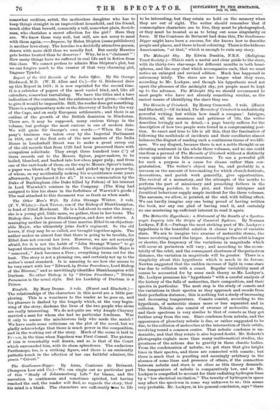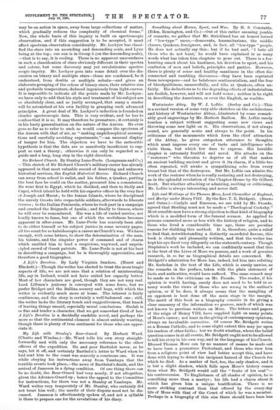The Meteoritic Hypothesis : a Statement of the Results of
a Spectro- scopic Inquiry into the Origin of Cosmical Systems. By Norman Lockyer, P.R.S.—Perhaps the most striking part of Mr. Lockyer's hypothesis is the beautiful solution it claims to give of variable stars. We are to imagine two swarms of meteoritic stones, the lesser revolving round the larger. According as the orbit is longer or shorter, the frequency of the variations in magnitude which will occur at periastron will vary; and according to the eccen- tricity of the orbit, and the consequent shortness of the periastron distance, the variation in magnitude will be greater. There is a simplicity about this hypothesis which is much in its favour. Newton suggested that the sudden increase of light in some stars was due to collision with a comet. Regular variability must of course be accounted for by some such theory as Mr. Lockyer's. Mr. Lockyer premises his " hypothesis " with a careful analysis of the history of the falls of meteorites, their composition, and their spectra in particular. The next step is the study of comets and the variations in their spectra as they approach and recede from their perihelion distance ; this is nothing but a study of increasing and decreasing temperature. Comets consist, according to the hypothesis, of meteoritic stones more or less separated and iu collision. Nebula: also consist of swarms of meteoritic stones, and their spectrum is very similar to that of comets as they get further away from the sun. Stars condense from nebulae, and the appearance of planetary nebulae is due, or rather suggested to be due, to the collision of meteorites at the intersection of their orbits, revolving round a common centre. That nebulae condense is un- deniable, and that they rotate is also beyond doubt. Mr. Roberts's photographs explain more than many mathematical studies, the greatness of the actions due to gravity in these chaotic bodies. From the condensation of nebulae, we get stars that give bright lines in their spectra, and these are connected with comets ; but there is much that is puzzling and seemingly arbitrary in the absence of some lines and presence of others, if the connection between nebulae and stars is as close as this theory demands. The temperature of nebulae is comparatively low, and so Mr. Lockyer is compelled to account for their radiating hydrogen lines by a " low electrical excitation." The tenuity of hydrogen in space may affect the spectrum in some way unknown to us; this seems very probable. Mr. Lockyer, in his general conclusion, says " there
may be an action in space, away from large collections of matter, which gradually reduces the complexity of chemical forms." Now, the whole basis of this inquiry is built on spectroscopic observation, and if this suggestion is to be accepted, it must affect spectrum observation considerably. Mr. Lockyer has classi- fied the stars into an ascending and descending scale, and Lyme being at the top ; our sun is in Group 5 (on the descending scale), —that is to say, it is cooling. There is no apparent unsoundness in such a classification of stars obviously different in their spectra and colour, but some discovery may yet revolutionise spectro- scopic inquiry. Mr. Lockyer goes into some detail over the dis- cussion on binary and multiple stars—these are condensed, be it understood, from double or multiple nebulae—and gives an elaborate grouping of the colour of binary stars, their relative size and probable temperature, deduced ingeniously from light-curves. It is impossible to indicate all the points made by Mr. Lockyer we have only to add that his style and treatment of his subject are so absolutely dear, and so justly arranged, that many a reader will be astonished at his own facility in grasping such advanced principles. A great deal of Mr. Lockyer's induction is founded on slender spectroscopic data. This is very evident, and he has to confess that it is so. It may therefore be premature ; it certainly is in his hasty generalisation on the nature of the Aurora. He even goes so far as to refer to such as would compare the spectrum of the Aurora with that of air, as "making unphilosophical assump- tions and carefully avoiding experiments,"—an unusual display of temper for him. The objection we have to the meteoritic hypothesis is that the data are so manifestly insufficient to sup- port so vast a theory ; otherwise it can only be regarded as a guide and a long, long step in the right direction.



















































 Previous page
Previous page